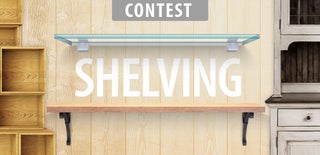Introduction: TS1 Modular Shelving (with CNC Wood Threading)
TS1 is modular shelving unit, relying on threaded wooden rods made with a CNC router. It’s my latest design & I’d like to share how I made it. More info on the finished product on my website.
Although it can be done with a hobby grade CNC (like the x-carve) it does require some special tools and possibly small modifications in the CNC bed (like drilling a big hole).
Step 1: Materials
- A sheet of 2440mm x 1220 mm 18 mm (4’ x 8’x ¾”) Plywood (or any plate material for that matter)
- 38mm (1 ½ “) square or round stock, hardwood of your choice (I used birch)
For the sake of making this instructable shorter I won’t cover how to make round stock from a rough board. Internet is full of those. Here’s one way to do it: https://www.instructables.com/id/Making-Dowel-Rod...
Step 2: Tools
- CNC router (x-carve in my case)
- End mill - cutting radius 10 mm (25/64”), flute length - 45mm (~1.8”)
- Thread mill - cutting radius 19mm (¾”), flute length - 50mm (~2”)
I purchased mine from here: https://www.keocutters.com/product/72800/ - Basic woodworking tools (tablesaw, drill, drill bits, hand-sander, jigsaw)
Step 3: CNC Files
I’m sharing the g-code files exported from Fusion 360, meant to be used with easel on the x-carve. However I’m also sharing the Fusion 360 models, so you can easily export it to other formats (I think?)
Step 4: Preparing the CNC for Clamping of Long Round Stock
If your CNC setup is similar to ours it will require drilling into the bed (I’ve drilled it on the far left corner), make the hole slightly larger than the rod itself - 30mm (1 3/16”).
Here’s my solution of how to clamp down the wooden rods. A simple clamp made from plywood, that’s mounted in existing holes on the x-carve bed with 4 bolts. The camping mechanism itself is dead simple, just a few bolts and half round plates that clamp around the rods.
Step 5: Machining the Threads
Cut the round stock to final lengths. If you’re building following my example precisely you’ll need:
- 20 pcs - 355mm (14“)
- 4 pcs - 100mm (3.9“)
- 4 pcs - 140mm (5.5“)
There are two steps on each piece being threaded. First step is preparing the tenon (or mortise) with a flat end mill. Second step is machining the thread with that special bit.
I’ve shared two pairs of files, each pair is meant for its respecting thread. One for the outside thread & one for the inside thread (be extra careful to not mix these up, speaking from experience...)
The files provided have a starting point at the top-center of the stock. Make sure to align it perfectly when you home your CNC, you only need to do it once.
Make sure the rods are sticking out enough above the bed (the tenon is ~40mm (1 ⅔ ”) in height).
Step 6: The Shelves
This part is pretty straight forward. Again, if you want to copy the example I made you’ll need:
- 6 pcs of 18mm (¾”) pine plywood (good quality) - 310mm x 1000mm (12.2” x 39.4”)
Once the parts are cut out mark the locations of the four holes on each plate. Mark the round corner from center of each hole with a compass.
Drill the holes just a bit bigger diameter than the tenon, in this case I drilled 28mm (1.1”) holes, as the tenon is 26mm (1.02” ). That gives you some tolerance in case the holes are not marked dead on the same throughout all shelves.
Next cut off the round corners with a jigsaw just outside pencil line & sand it until you reach the marks. I have a luxury of a belt-sander with a table but the job can be done just as good by hand sanding.
Step 7: Finsih
All that’s left is to do is finish sanding the whole project, apply some oil/lacquer of your choice (I didn't varnish the threads) and assemble it! In my case I used 2 part polyurethane varnish. It doesn’t yellow the wood & leaves the appearance of unfinished material while having very durable layer of protection.
If all went as planned by now you should have yourself a shelving unit! No glue or metal fixtures required! Just screw the shelves together in between these wooden bolts.
To get a better sense of how to put it all together you can watch the short video above where I take it all apart...
Congratulations!

Third Prize in the
Shelving Contest 2016















